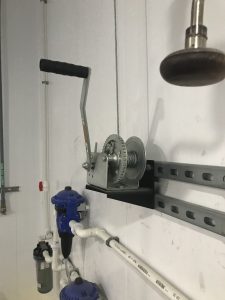In the Department of Agricultural and Biosystems Engineering, research can range from power machinery, to occupational safety, to piglet research and other research in between. For four seniors in the department: Austin Marshek, Max Lindgren, Logan Heims and Hunter Frerichs, their research for their senior capstone project combines many of these elements – livestock, machinery and safety.
What started with hearing from the Environmental Health and Safety team at Iowa State (EH&S) about a hazardous device ended with the team creating a new weight-bearing system for use at the Robert T. Hamilton Poultry Teaching & Research Facility at Iowa State University. After visiting the facility, they were introduced to a problem related to the winch, a device used to support the weight-bearing in the feed delivery system, impacting the safety of the poultry farm employees. This winch was used to temporarily lift the feeders for the chickens so employees can efficiently clean the area that the chickens are in.
According to EH&S, the placement of the winch was head level to many of the employees, posing the risk of possible head injuries, and on top of that, the winch had carried so much weight that it was beginning to detach from the wall – so it was up to the capstone team to resolve this issue.

“The issue with the winch handle was that it was pulling away from the wall and breaking because of the weight of the feeders, and most of the people that work there are not tall enough to pull the handle without it being a safety hazard,” Marshek said. “Our goal was to redesign this area so that it would no longer be pulling away from the wall and be more structurally sound, and we then can get rid of the handle so it is no longer a safety hazard.”

When the team first was assigned this project, their initial goal was the design of the winch. Now, the team has calculated how many new winches are needed and are planning to install the new winches in August.
Part of the seniors’ design includes increasing the surface area of the metal plate that the winch is attached to and therefore dispersing weight through a larger area. With the larger plate, the chances of the winch pulling from the wall are less. The team will also be adding different bolts to help with weight distribution and adjusting the handles.
The cost to complete this project is highly affordable – costing only a couple hundred dollars to completely renovate the winch.
Going into this project, the team wasn’t expecting to do a full-cycle project like this one. But similar to industry work, sometimes one problem can bring up another, and then an even better solution, according to the team’s advisor and professor, Gretchen Mosher.
“This is a clear example of something that we thought we knew what the solution was going to be, but after digging into it a little bit deeper we found more problems to solve, and it becomes a little bit of a different problem,” Mosher said. “But solving this problem can lead to so many different and new solutions.”
After the team officially executes the plan to fix the winch, their design can potentially be implemented across the facility, and even across other areas in the industry.
